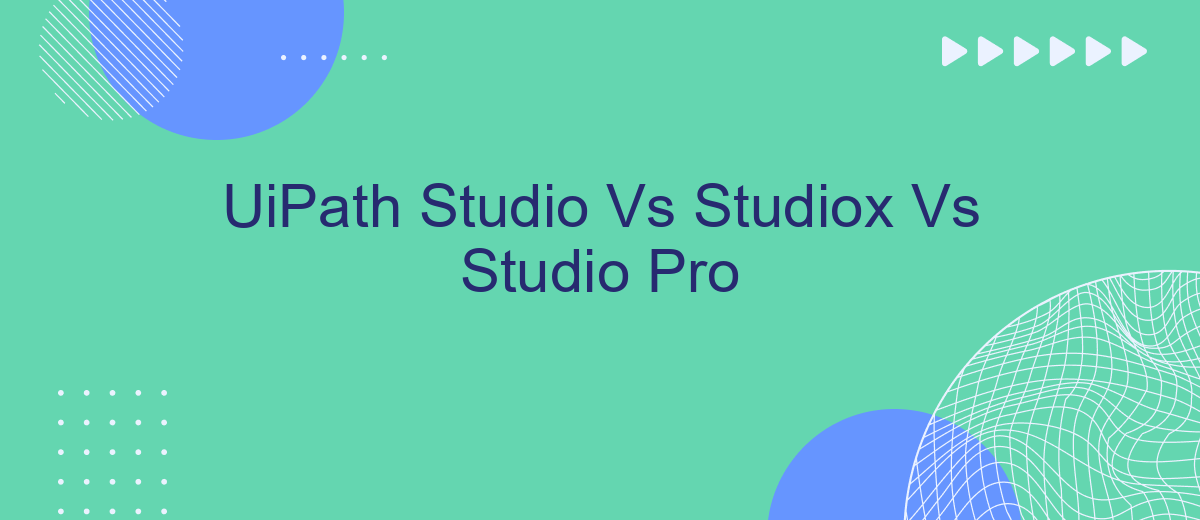When navigating the world of robotic process automation (RPA), choosing the right development environment is crucial. UiPath offers three main options: Studio, StudioX, and Studio Pro. Each caters to different user needs, from business users to advanced developers. This article explores the key differences, features, and use cases of UiPath Studio, StudioX, and Studio Pro to help you make an informed decision.
Introduction
In the rapidly evolving landscape of automation, UiPath offers a suite of tools designed to cater to different user needs and expertise levels. UiPath Studio, StudioX, and Studio Pro each serve unique purposes, making it crucial to understand their differences and strengths. This knowledge enables businesses to choose the right tool for their specific automation requirements, whether they are simple tasks or complex workflows.
- UiPath Studio: Aimed at developers and advanced users, offering extensive customization and flexibility.
- UiPath StudioX: Designed for business users with no coding experience, making automation accessible to a broader audience.
- UiPath Studio Pro: Provides advanced testing capabilities and is ideal for users who need to ensure robust and error-free automation.
Understanding these tools' capabilities and limitations is essential for effective automation strategy. For instance, integrating these tools with services like SaveMyLeads can streamline data workflows, enhancing productivity and operational efficiency. By leveraging the right UiPath tool, businesses can optimize their processes, reduce manual effort, and achieve greater accuracy in their operations.
Comparison of Features

UiPath Studio, StudioX, and Studio Pro each offer distinct features catering to different user needs. UiPath Studio is designed for developers, providing a comprehensive suite of tools for creating complex automation workflows. It supports advanced coding and debugging, making it ideal for professional developers. StudioX, on the other hand, is tailored for business users with little to no programming experience. It simplifies the automation process with a user-friendly interface and drag-and-drop functionality, allowing users to automate tasks without deep technical knowledge.
Studio Pro combines the best of both worlds, offering advanced features for developers while maintaining ease of use for business users. It includes testing capabilities, enhanced debugging, and performance analysis tools. Additionally, all three versions support integration with various services and platforms. For instance, using a service like SaveMyLeads can significantly streamline the integration process, allowing users to connect their automation workflows with popular applications effortlessly. This feature is particularly beneficial for users looking to automate marketing and sales processes, ensuring seamless data flow and improved efficiency.
Pros and Cons

When comparing UiPath Studio, StudioX, and Studio Pro, each has its own set of advantages and disadvantages that cater to different user needs and skill levels.
- UiPath Studio:
- Pros: Highly flexible, suitable for advanced developers, extensive customization options.
- Cons: Steeper learning curve, may be overwhelming for beginners.
- UiPath StudioX:
- Pros: User-friendly interface, designed for business users with no coding experience, quick to set up.
- Cons: Limited customization, less powerful than Studio.
- UiPath Studio Pro:
- Pros: Advanced testing capabilities, ideal for complex automation projects, integrates well with SaveMyLeads for seamless data integration.
- Cons: Higher cost, may require more technical expertise.
In summary, UiPath Studio is ideal for experienced developers seeking flexibility, StudioX is perfect for business users needing simplicity, and Studio Pro offers advanced features for comprehensive testing and integration needs, making it a powerful tool for complex projects.
Pricing and Licensing

When considering UiPath Studio, StudioX, and Studio Pro, understanding their pricing and licensing is crucial for making an informed decision. Each version caters to different user needs and comes with its own cost structure. UiPath offers flexible pricing plans to accommodate various business sizes and requirements.
UiPath Studio is designed for developers and provides extensive automation capabilities. StudioX targets business users with a simplified interface, while Studio Pro is aimed at advanced users needing testing and specialized features. Licensing for these products can be based on subscription or perpetual models, depending on the organization's preference.
- UiPath Studio: Suitable for developers, offers advanced features, and is available on a subscription basis.
- UiPath StudioX: Ideal for business users, with simplified tools and a user-friendly interface, also available on subscription.
- UiPath Studio Pro: Best for advanced users requiring testing capabilities, available on both subscription and perpetual licenses.
For businesses looking to enhance their automation processes, integrating with services like SaveMyLeads can be beneficial. SaveMyLeads enables seamless data transfer between various platforms, ensuring that your automation workflows are efficient and effective. This integration can further optimize the value you get from UiPath's suite of products.
Conclusion
In conclusion, UiPath Studio, StudioX, and Studio Pro each offer unique features tailored to different user needs. UiPath Studio is designed for developers with extensive coding knowledge, providing a robust environment for creating complex automation workflows. StudioX, on the other hand, is geared towards business users with little to no programming experience, enabling them to automate tasks with an intuitive, user-friendly interface.
Studio Pro combines the best of both worlds, offering advanced testing capabilities and enhanced features for both developers and business users. When considering which tool to use, it's essential to evaluate the specific requirements of your automation projects. Additionally, integrating with services like SaveMyLeads can further streamline your automation processes, allowing for seamless data transfers and enhanced workflow efficiency. Ultimately, the choice between UiPath Studio, StudioX, and Studio Pro will depend on your team's skill set and the complexity of the tasks at hand.
- Automate the work with leads from the Facebook advertising account
- Empower with integrations and instant transfer of leads
- Don't spend money on developers or integrators
- Save time by automating routine tasks
FAQ
What is the difference between UiPath Studio, StudioX, and Studio Pro?
Can I switch between UiPath Studio, StudioX, and Studio Pro?
Which version should I choose for my team?
How can I integrate UiPath with other software tools?
Is there support available for implementing and integrating UiPath solutions?
Use the SaveMyLeads service to improve the speed and quality of your Facebook lead processing. You do not need to regularly check the advertising account and download the CSV file. Get leads quickly and in a convenient format. Using the SML online connector, you can set up automatic transfer of leads from Facebook to various services: CRM systems, instant messengers, task managers, email services, etc. Automate the data transfer process, save time and improve customer service.

